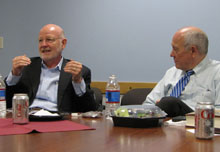Event
Percentage of foreign news today is up, says John M. Hamilton

November 9, 2009 — In his Shorenstein Center brown-bag talk, “Journalism’s Roving Eye: American Newsgathering Abroad,” John M. Hamilton, Dean of the Manship School of Mass Communication at Louisiana State University, traced the historical and current state of foreign journalism.
Hamilton said that “historically, foreign news has always, always been in short supply,” with the exception of colonial America, when overseas newspapers were often reprinted and distributed. The face of international reporting changed, Hamilton said, when news became a “commercial product” and reporters and editors began to specialize in international news.
Even though foreign reporting has always had a small audience, Hamilton pointed out that the “percentage of foreign news in newspapers today is slightly up.” While wars tend to get lots of attention, Hamilton noted that “they are really local stories … about our kids going abroad,” and international news “does have an impact on our lives, but it’s not as immediate and tangible.”
Hamilton described the “golden period” in international reporting between the two world wars, when there were many opportunities for journalists, such as wire services, magazines and radio. Technological constraints also played a part, as reporters were not able to correspond with their editors on a daily basis. Hamilton recognized that while it was “sometimes inefficient when reporters were not in touch with the home office,” such limits allowed small foreign services to cover “news that wouldn’t have been news” by editors’ standards.
Looking at the future of foreign journalism, Hamilton said that people who “lament about American journalism tend to be ahistorical.” Journalism is a “relatively young profession,” so it “shouldn’t be surprising that it’s trying to find its way.” He sees a “proliferation of models for the foreseeable future” as well as a “proliferation of economic models for supporting news,” citing Bloomberg and GlobalPost as examples of successful international news organizations.
This article was written by Janell Sims and the photos taken by Leighton Walter Kille, both of the Shorenstein Center.